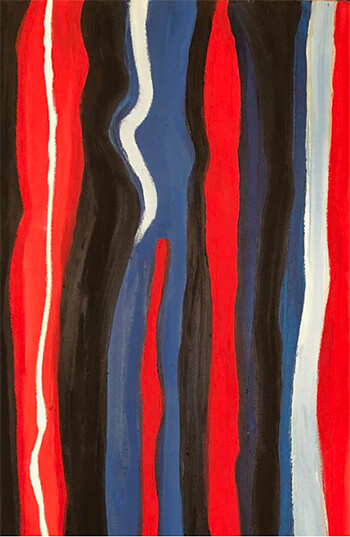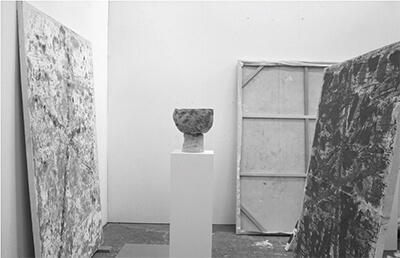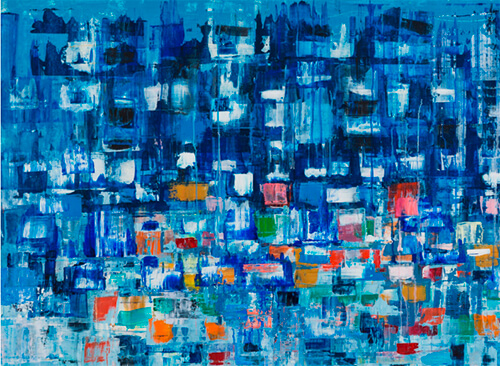
It’s a Saturday afternoon in late February. Art lovers and creatives are arriving for a pair of exhibit openings in the adjacent art galleries of Catharine Clark and Brian Gross, at 248 Utah Street. The spacious rooms rapidly fill with perhaps 100 guests sipping wine and conversing in small groups that mix, disperse and regroup. Among the crowd are couples with their children, the youngest in strollers, to celebrate art and the locals who produce it.
The Catharine Clark Gallery was showing works by Andy Diaz Hope and Laurel Roth Hope. The couple live nearby, in the Mission District. Throughout their careers, the Hopes have created work that focuses on the environment and conservation, the dissemination of information through mass media, and the relationship between narrative and spirituality. The recent showing, themed An Exhaustive Study of Power, imagined an immersive space that employs the aesthetics of a richly appointed apartment overlooking a world on the brink of societal collapse. In one room, Laurel’s “Manifest Destiny,” a study of European starlings in vitreous china, glazes, wood, and gold leaf, explored invasive species’ impact on habitat and native populations.
Artists have lived and worked in Potrero Hill and Dogpatch for decades. But after several art galleries relocated to the neighborhoods from tonier Downtown and South-of-Market spaces in 2013, a newfound “awareness of the predicament for creatives in the area” inspired Clark to organize the informally recognized DoReMi Arts District, reflecting the Dogpatch, Potrero and Mission District neighborhoods the area encompasses. Steeply increasing rents, a byproduct of the latest technology boom, have forced many departures from San Francisco. The lower fees charged in blocks zoned as Production, Distribution and Repair, home to former warehouses that readily adapt to spacious artist studios, make these communities a stronghold for the imaginative set.
“It’s never been easy for artists and creatives in general,” Clark said. DoReMi “has given us hope. We’re in it together and there’s some effort to solve the problem.”
The district’s proximity to the San Francisco Design Center, with its showrooms and businesses dedicated to remodeling, designing and decorating well-appointed homes, is a bonus. Other Utah Street enterprises include the Hosfelt Gallery, owned by Todd Hosfelt, and Daltile Design Studio, which specializes in high-end floor tiles.
“Serious collectors buy first and figure out where it will go later, but others are looking to balance design with art, so this is a convenience,” Brian Gross said. “I love being in this District. I was Downtown for 30 years. We were all squeezed into office buildings. Here, we have space and natural light and parking. We don’t get the foot traffic that we would Downtown, but we get a lot of destination traffic. It’s a friendlier area than Downtown. It’s a residential area that’s more accessible to customers who want to buy art for their homes.”
Until April 6 the Brian Gross Gallery is showing Eden In Iraq, a solo exhibition of eight new photographic works by Santa Fe artist Meridel Rubenstein that explore themes of destruction and renewal through the social, political, and environmental history of Southern Iraq, believed to be the location of the Biblical Eden on Earth.
“Galleries have always benefitted from being close together,” said Clark. “Everyone shows different artists. Yes, there’s competition, but it’s more about the conversation than the competition.”
A pocket-sized pamphlet with a map identifies 54 galleries and design studios in DoReMi, with several galleries clustered around Utah and Minnesota streets. In between, the Wattis Institute of the Arts, part of the California College of the Arts, is located at 360 Kansas Street. The nearby Center for the Book, at 375 Rhode Island Street, conducts 400 workshops annually in letterpress printing, calligraphy and bookbinding, while displaying traditional and experimental book forms and handcrafted greeting cards in classic fonts. Visitors can see ornate letterpresses that date back to the late-1800s.


The Minnesota Street Project opened in 2016. Founded by angel investors, Andy and Deborah Rappaport, themselves collectors of fine art, MSP offers economical warehouse spaces for art galleries, artists and related nonprofits. The galleries at 1275 Minnesota and 1150 25th streets are free and open to the public during regular business hours. The Artist Studio Program at 1240 Minnesota Street is tenants-only.
Committed to helping gallerists and artists sustain themselves through sales, MSP is also dedicated to educating the public through open, accessible engagement with exhibitions and programming. The facility houses 17 gallery spaces in addition to the studio program. Selection of 35 artists from 300 who applied for MSP studios was in part based on their willingness to organize, something many artists find challenging, as their creative lives demand the lion’s share of their time and energy.
“This was about confirming a long-term relationship. We considered the contributions the artists were making outside of their art, within the art community. We filled it with individuals who are natural organizers,” said Brion Nuda Rosch, of Minnesota Street Project, who wears several hats. In addition to his role as studio program director, Rosch is a painter, sculptor, and art teacher. He works with schools and takes young students into the studio to show them how to work with paints and clay.
“It’s more than sharing a studio practice with children,” Rosch noted. “Sharing a community of working artists is what will inspire them in the future. Can you imagine being shown a building filled with working artists at a young age? It solidifies the importance of art in our lives. Space has been claimed and there is support for artists to work. Showing that to youth today will ensure they understand later in life that supporting the arts is important. It isn’t necessarily important for everyone to grow up to be an artist. What’s important is that people grow up to understand art. When people understand art that they will support the art community, buying art, investing in the community as philanthropists.”
In its 50th anniversary season, the San Francisco Arts Education Project explores the relationship between artist-mentor and student-artist in Dialogues 2019: Artist Mentors & Their Students. Running through May 25 at 1275 Minnesota Street, the exhibition features work by older and younger artists, the latter of whom are public elementary school students. It provokes the questions: who inspires whom? Is resonance reciprocal?
“SFArtsEd is a vital part of Minnesota Street Project’s community of contemporary galleries and arts organizations,” said Julie Casemore, MSP director. “Their mission of education and mentorship contributes significantly to one of Minnesota Street Project’s goals, to open the doors wide to the greater community, including young people.”
At DoReMi’s easternmost edge is the Noonan Building, located at Pier 70, which has housed a variety of artists for 40 years, including Frank Lobdell, one of the pioneers of Bay Area abstract expressionism. The large, wood framed structure, built in 1941, is scheduled to be torn down to make way for a new development by Brookfield Properties, the successor to Forest City.
Initially overlooked in Pier 70’s development plans, the Noonan artists banded together to advocate to be included in the future complex. As a result, Brookfield Properties’ will work with a nonprofit arts organization – possibly the Community Arts Stabilization Trust – to build, own and operate a new waterfront arts facility that’ll be home to the Noonan artists currently onsite. Base rent for the Noonan artists will be held at low rates. Approved project zoning allows for a building of up to 50 feet tall. The new three-level edifice may include a gallery open to the public, as well as an elevator, a feature that’s absent from the Noonan Building.
Pier 70’s atmospheric location itself is inspirational, a place where a post-industrial landscape gives way to Bay views of maritime cargo ships passing by.
“I look out and have a view of the Bay. The water view will creep into some of the works. The big sky, the water. Kind of industrial at the same time. It helps to inform the paintings,” said Daniel Phill, who has worked in his Noonan Building studio for 16 years. Phill described his work as abstract botanical, abstract floral landscapes, with an emphasis on expressionism, alluding to flowers and vegetation. His pieces are on display this month at the San Francisco Museum of Modern Art Artist Gallery at Fort Mason, part of a benefit sale.

“The location has provoked a whole new phase of my work,” said painter Suzy Barnard – a former Hill resident who now lives in Berkeley – who moved into the Noonan Building in 2003. “Views of the water have instigated a whole new exploration of water and light. Seeing these industrial ships that are visible outside my window, sort of appearing and disappearing in the light. The imagery in my work is very dissolved. This particular environment has had a very huge impact on my work as an individual. It still feeds me. I’m very grateful that I’ve been able to be here this long.”

While the artist workshops are private, the popular San Francisco Open Studios, organized by ArtSpan, offers the public an opportunity to visit Noonan Building spaces on a designated weekend in the fall.
“If this all works out, it’s a rare thing for artists to get space like this from the developer,” Barnard said of the Noonan Building’s future replacement. “Any of us who make it to that point, with all the construction and displacement and relocation, will have a great thing. You’ll have your studio space and be surrounded by things that work for you. That’s a pretty exciting prospect, if we can make it that far, and if it really happens.”
An innovative solution to protect artists from eviction is Goodman 2, at 1695 18th Street, which opened in 1996 after 13 years of planning by the nonprofit Art Space Development Corporation and executive director Martha Senger. The complex includes market- and below- market rate condominiums with five subsidized live-work studio rentals initially offered to artists who’d been dispossessed from the original Goodman building, located on Geary Boulevard between Franklin and Van Ness. Goodman 2 is now home to nine artists actively engaged in fine arts.
Sofia Carmi, who was evicted from the Certa Building with 25 other artists and moved into Goodman 2 in 2007, paints in oil and acrylic on canvas. Her art, a mix of fantasy, visions, memory, mystery, color, form and texture, is part of a three-women show, Conversations in paint with 3 Goodman 2 artists; Anahida, Sofia Carmi, and Carolyn Crampton, being shown this month in Goodman 2’s hallway atrium, which can be seen by appointment. Carmi will also show works at the 61st Annual Potrero Hill Artists Exhibition, which opens May 4 and runs through July 26.
“We’re always looking for new people, though some of the artists have been exhibiting at the annual event for 50 years,” said Potrero Hill Branch Library Manager Genevieve Feldman. “The first Artists Exhibition at the Potrero Hill Library was organized by a local artist with the goal of saving the branch library from closing down. At the time, a bunch of artists from the North Beach artists community had relocated to the Dogpatch and Potrero Hill, where the rents were more affordable. Rent in North Beach had gone up to $99 a month!”
San Francisco is running out of affordable real estate for collectives like the Minnesota Street Project, Goodman 2, the Noonan Building, and art galleries to reside in. “San Francisco is a Gold Rush town and we’ve had two big tech booms. We have industries that are thriving and we have the creative community that is still struggling,” Rosch said. “The impetus of starting Minnesota Street Project was the year 12 galleries in San Francisco failed, when their rents tripled and quadrupled in one year. There are galleries here that now have that stability.”
Rosch and other artists observed that well-off newcomers to San Francisco often appear unaware of displacement caused by gentrification and a rapacious real estate market. “We currently don’t have companies feeling that they are an actual part of a city to that scale,” Rosch said. “Let’s get the bright minds together and have this hard conversation. It’s important for people to take responsibility for some of the displacement that their wealth and success causes. I’m interested in developing conversations around new forms of philanthropy that can adopt what we’ve learned during the development of Minnesota Street Project. Imagine what could be accomplished with the support of a company or companies valued in the billions. We need more infrastructure in the arts, to secure more capital and develop more infrastructure to provide space to work, to provide space to show. What needs to happen is we need to scale this up, work with industries that are thriving and find fiscal contributions to secure more space before it’s gone.”
“Greater awareness on the part of private industry would be welcome,” Phill said.
“More venues, that kind of awareness would be more positive for everybody,” Barnard said. “Not just the artists, the public at large would benefit. The MSP is interesting to watch. I’m glad they’re doing that.”
“It’s up to me as an artist to educate. But to bridge that gap, you have to start someplace. An exhibit,” Carmi said. “It’s not just buying, it’s attending. Come and attend an event. Show up.”

